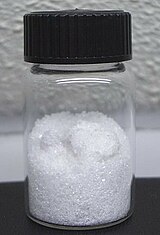Silver nitrate
 |
|
 |
|
| Names | |
|---|---|
|
IUPAC name
Silver(I) nitrate, Silver nitrate
|
|
| Other names
Nitric acid silver(1+) salt
|
|
| Identifiers | |
|
7761-88-8 |
|
| 3D model (Jmol) | Interactive image |
| ChEBI |
CHEBI:32130 |
| ChEMBL |
ChEMBL177367 |
| ChemSpider |
22878 |
| ECHA InfoCard | 100.028.958 |
| EC Number | 231-853-9 |
| PubChem | 24470 |
| RTECS number | VW4725000 |
| UNII |
95IT3W8JZE |
| UN number | 1493 |
|
|
|
|
| Properties | |
| AgNO3 | |
| Molar mass | 169.87 g·mol−1 |
| Appearance | colorless solid |
| Odor | Odorless |
| Density | 4.35 g/cm3 (24 °C) 3.97 g/cm3 (210 °C) |
| Melting point | 209.7 °C (409.5 °F; 482.8 K) |
| Boiling point | 440 °C (824 °F; 713 K) decomposes |
| 122 g/100 mL (0 °C) 170 g/100 mL (10 °C) 256 g/100 mL (25 °C) 373 g/100 mL (40 °C) 912 g/100 mL (100 °C) |
|
| Solubility | Soluble in acetone,ammonia, ether, glycerol |
| Solubility in acetic acid | 0.776 g/kg (30 °C) 1.244 g/kg (40 °C) 5.503 g/kg (93 °C) |
| Solubility in acetone | 0.35 g/100 g (14 °C) 0.44 g/100 g (18 °C) |
| Solubility in benzene | 0.22 g/kg (35 °C) 0.44 g/kg (40.5 °C) |
| Solubility in ethanol | 3.1 g/100 g (19 °C) |
| Solubility in ethyl acetate | 2.7 g/100 g (20 °C) |
| log P | 0.19 |
| −45.7·10−6 cm3/mol | |
|
Refractive index (nD)
|
1.744 |
| Viscosity | 3.77 cP (244 °C) 3.04 cP (275 °C) |
| Structure | |
| Orthorhombic, oP56 | |
| P212121, No. 19 | |
| 222 | |
|
a = 6.992(2) Å, b = 7.335(2) Å, c = 10.125(2) Å
α = 90°, β = 90°, γ = 90°
|
|
| Thermochemistry | |
| 93.1 J/mol·K | |
|
Std molar
entropy (S |
140.9 J/mol·K |
|
Std enthalpy of
formation (ΔfH |
−124.4 kJ/mol |
|
Gibbs free energy (ΔfG˚)
|
−33.4 kJ/mol |
| Pharmacology | |
| D08AL01 (WHO) | |
| Hazards | |
| Main hazards | Explosively reacts with ethanol. Corrosive. |
| GHS pictograms |
  
|
| GHS signal word | Danger |
| H272, H314, H410 | |
| P220, P273, P280, P305+351+338, P310, P501 | |
|
EU classification (DSD)
|
|
| R-phrases | R8, R34, R50/53 |
| S-phrases | S26, S36/37/39, S45, S60, S61 |
| NFPA 704 | |
| Lethal dose or concentration (LD, LC): | |
|
LDLo (lowest published)
|
800 mg/kg (rabbit, oral) 20 mg/kg (dog, oral) |
|
Except where otherwise noted, data are given for materials in their standard state (at 25 °C [77 °F], 100 kPa).
|
|
|
|
|
| Infobox references | |
Silver nitrate is an inorganic compound with chemical formula AgNO
3. This compound is a versatile precursor to many other silver compounds, such as those used in photography. It is far less sensitive to light than the halides. It was once called lunar caustic because silver was called luna by the ancient alchemists, who believed that silver was associated with the moon.
In solid silver nitrate, the silver ions are three-coordinated in a trigonal planar arrangement.
Albertus Magnus, in the 13th century, documented the ability of nitric acid to separate gold and silver by dissolving the silver. Magnus noted that the resulting solution of silver nitrate could blacken skin.
Silver nitrate can be prepared by reacting silver, such as a silver bullion or silver foil, with nitric acid, resulting in silver nitrate, water, and oxides of nitrogen. Reaction byproducts depend upon the concentration of nitric acid used.
This is performed under a fume hood because of toxic nitrogen oxide(s) evolved during the reaction.
A typical reaction with silver nitrate is to suspend a rod of copper in a solution of silver nitrate and leave it for a few hours. The silver nitrate reacts with copper to form hairlike crystals of silver metal and a blue solution of copper nitrate:
Silver nitrate decomposes when heated:
Qualitatively, decomposition is negligible below the melting point, but becomes appreciable around 250 °C and totally decompose at 440 °C.
Most metal nitrates thermally decompose to the respective oxides, but silver oxide decomposes at a lower temperature than silver nitrate, so the decomposition of silver nitrate yields elemental silver instead.
Silver nitrate is the least expensive salt of silver; it offers several other advantages as well. It is non-hygroscopic, in contrast to silver fluoroborate and silver perchlorate. It is relatively stable to light. Finally, it dissolves in numerous solvents, including water. The nitrate can be easily replaced by other ligands, rendering AgNO3 versatile. Treatment with solutions of halide ions gives a precipitate of AgX (X = Cl, Br, I). When making photographic film, silver nitrate is treated with halide salts of sodium or potassium to form insoluble silver halide in situ in photographic gelatin, which is then applied to strips of tri-acetate or polyester. Similarly, silver nitrate is used to prepare some silver-based explosives, such as the fulminate, azide, or acetylide, through a precipitation reaction.
...
Wikipedia

